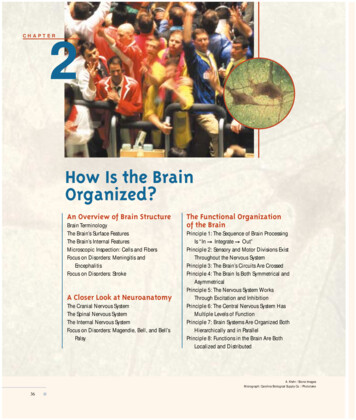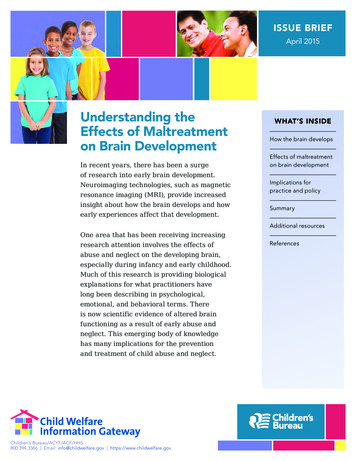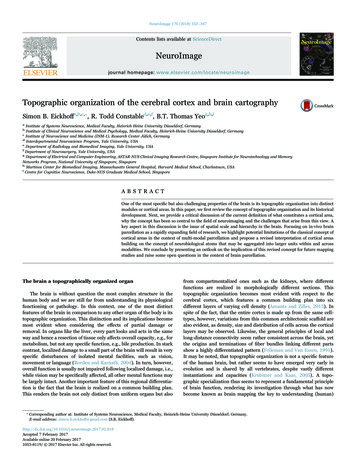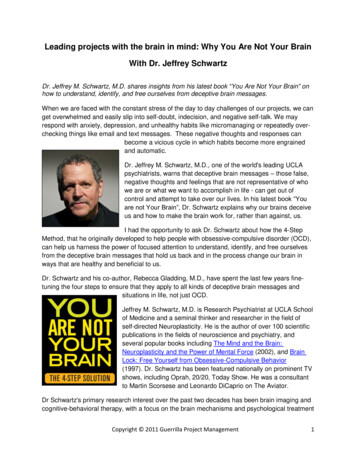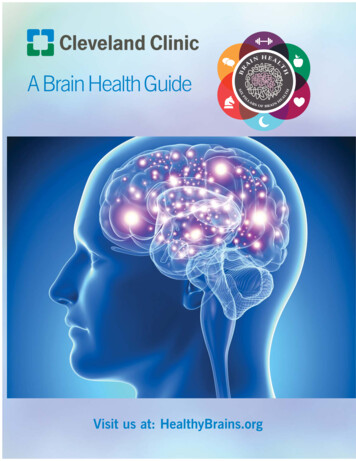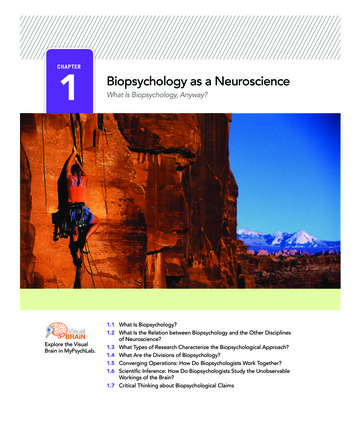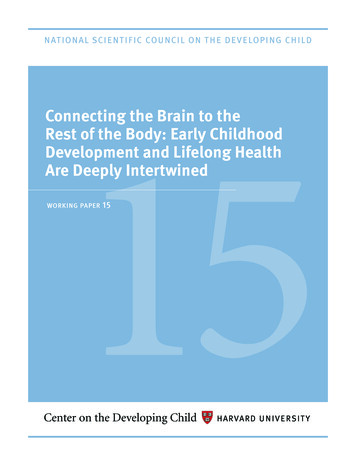
Transcription
15Connecting the Brain to theRest of the Body: Early ChildhoodDevelopment and Lifelong HealthAre Deeply IntertwinedWORKING PAPER15
This paper isdedicated toBruce S. McEwen, Ph.D.(1938-2020)MEMBERSJack P. Shonkoff, M.D., ChairJulius B. Richmond FAMRI Professor of Child Health andDevelopment, Harvard T.H. Chan School of Public Healthand Harvard Graduate School of Education; Professorof Pediatrics, Harvard Medical School and Boston Children’s Hospital; Research Staff, Massachusetts GeneralHospital; Director, Center on the Developing Child,Harvard UniversityPat Levitt, Ph.D, Science Co-ChairSimms/Mann Chair in Developmental Neurogenetics,Institute for the Developing Mind, Children’s HospitalLos Angeles; W.M. Keck Provost Professor in Neurogenetics, Keck School of Medicine, University of SouthernCaliforniaSPONSORSThe Alliance for EarlySuccessBuffett Early ChildhoodFundChan Zuckerberg InitiativeGenentechImaginable FuturesThe JPB FoundationThe LEGO FoundationOverdeck Family FoundationThe David and LucilePackard FoundationPritzker Children’s InitiativeThe Simms/Mann FamilyFoundationTikun Olam FoundationNathan A. Fox, Ph.D., Science Co-ChairDistinguished University Professor, Department ofHuman Development and Quantitative Methodology,Program in Neuroscience and Cognitive Science; Director, Child Development Lab, University of MarylandJudy Cameron, Ph.D.Professor of Psychiatry, Neuroscience, ObstetricsGynecology Reproductive Sciences, and Clinical andTranslational Science, University of Pittsburgh; Directorof Outreach, School of Medicine, University of PittsburghGreg J. Duncan, Ph.D.Distinguished Professor, Department of Education,University of California, IrvineDamien Fair, PA-C, Ph.D.Professor, Institute of Child Development, Department ofPediatrics; Director, Masonic Institute for the DevelopingBrain, University of MinnesotaPhilip A. Fisher, Ph.D.Philip H. Knight Chair; Professor of Psychology, University of Oregon; Senior Fellow, Center on the DevelopingChild at Harvard UniversityMegan R. Gunnar, Ph.D.Regents Professor and Distinguished McKnight University Professor, Institute of Child Development, Universityof MinnesotaTakao Hensch, Ph.D.Professor of Molecular and Cellular Biology, HarvardFaculty of Arts and Sciences; Professor of Neurology,Harvard Medical School at Children’s HospitalFernando D. Martinez, M.D.Regents Professor; Director of the Arizona RespiratoryCenter; Director of BIO5 Institute; Director of the Clinicaland Translational Science Institute; Swift-McNear Professor of Pediatrics, University of ArizonaBruce S. McEwen, Ph.D.*Alfred E. Mirsky Professor; Head, Harold and MargaretMiliken Hatch Laboratory of Neuroendocrinology; TheRockefeller UniversityCharles A. Nelson, Ph.D.Professor of Pediatrics and Neuroscience, HarvardMedical School; Professor of Education, Harvard Graduate School of Education; Richard David Scott Chair inPediatric Developmental Medicine Research, BostonChildren’s HospitalPatrícia Pelufo Silveira, M.D., Ph.D.Assistant Professor, Department of Psychiatry, McGillUniversity; Primary Investigator, Ludmer Centre for Neuroinformatics and Mental Health* Dr. Bruce McEwen contributed in many ways to thedrafting of this paper before his untimely death inJanuary 2020. We greatly miss him as a person and asa world-leading expert whose wide-ranging knowledgeand gentle humor were so appreciated by the membersof the National Scientific Council and all of his manyadmirers and students.ACKNOWLEDGMENTSWe gratefully acknowledge the significant contributionsto this paper made by:Reggie Bicha, M.S.W., Shine Early LearningW. Thomas Boyce, M.D., University of California, SanFranciscoGloria Corral, M.P.P., Parent Institute for Quality EducationIheoma U. Iruka, Ph.D., HighScope Educational ResearchFoundationNat Kendall-Taylor, Ph.D., FrameWorks InstituteJoan Lombardi, Ph.D., Early OpportunitiesMichael J. Meaney, Ph.D., McGill University; SingaporeInstitute for Clinical Sciences, Agency for Science, Technology & Research; Yong Loo Lin School of Medicine,National University of SingaporeAaliyah Samuel, Ed.D., NWEAMandy Sorge, M.A.Ed. and Beth Caron, Ph.D., NationalGovernors AssociationDonna Wilson, Ph.D., National Conference of StateLegislaturesAbout the AuthorsThe National Scientific Council on the Developing Child, housed at the Center on the Developing Child at Harvard University, is a multi- disciplinary collaboration designed to bring the science of early childhood and early brain development to bear on public decision- making.Established in 2003, the Council is committed to an evidence-based approach to building broad-based public will that transcends politicalpartisanship and recognizes the complementary responsibilities of family, community, workplace, and government to promote the wellbeing of all young children. For more information, go to www.developingchild.net.Please note: The content of this paper is the sole responsibility of the authors and does not necessarily represent the opinions of the sponsors.Suggested citation: National Scientific Council on the Developing Child. (2020). Connecting the Brain to the Rest of the Body: Early Childhood Development and Lifelong Health Are Deeply Intertwined: Working Paper No. 15. Retrieved from www.developingchild.harvard.edu JUNE 2020, NATIONAL SCIENTIFIC COUNCIL ON THE DEVELOPING CHILD, CENTER ON THE DEVELOPING CHILD AT HARVARD UNIVERSITY
The Issue: Health and Learning Are Interrelatedin the Body but Separated in PolicyA growing understanding of how responsive relationships and language-richexperiences for young children help build a strong foundation for later success in schoolhas driven increased investment and sparked innovation in early learning around the world.The rapidly advancing frontiers of 21st-century biological sciences now provide compellingevidence that the foundations of lifelong health are also built early, with increasing evidenceof the importance of the prenatal period and first few years after birth.1 The science is clear ontwo points:1.What happens during this period can have substantial effects on both short- and longterm outcomes in learning, behavior, and both physical and mental health.2.All of these domains are remarkably interdependent and the potential for learning isinexorably linked to the quality of physical and mental health.A child who is living in an environmentwith supportive relationships and consistentroutines is more likely to develop wellfunctioning biological systems, includingbrain circuits, that promote positivedevelopment and lifelong health. Childrenwho feel threatened or unsafe may developphysiological responses and coping behaviorsthat are attuned to the harsh conditionsthey are experiencing at the time,2 at thelong-term expense of physical and mentalwell-being, self-regulation, and effectivelearning.3 Policymakers, leaders of humanservices systems, intervention developers, andpractitioners can all use this knowledge tocreate innovative solutions to reduce disparitiesin preventable diseases and premature deathsand lower the high costs of health care forchronic illnesses that have their origins in earlychildhood adversity.4,5 Moreover, these costsare likely to grow unless society’s investmentin promoting health and preventing diseasemoves “upstream” to address the sources ofthese problems in early childhood.Nearly all aspects of early developmentand later health are affected by interactionsamong experiences, genes, age, and theenvironments in which young children live.These interactions influence every biologicalsystem in the body, with especially powerfuleffects in the earliest years.6,7 Systemsrelating to brain development, heart andWWW.DEVELOPINGCHILD.HARVARD.EDUlung function, digestion, energy production,fighting infection, and physical growthare all interconnected and influence eachother’s development and function. Eachsystem “reads” the environment, prepares torespond, and shares that information withthe others. Each system then “signals back”to the others through feedback loops that arealready functioning at birth.8 As an example,The environments we create and the experienceswe provide for young children and their familiesaffect not just the developing brain, but also manyother physiological systems.higher rates of infection in early childhoodcan increase the level of anxiety at laterages9, which can then compromise schoolperformance. Children living in conditionsof threat and deprivation may emerge asadults with a greater risk for multiple formsof cardiometabolic disease. In short, theenvironments we create and the experienceswe provide for young children and theirfamilies affect not just the developing brain,but also many other physiological systems,from cardiovascular function and immuneresponsiveness to metabolic regulation. All ofthese systems are responsible for our lifelongConnecting the Brain to the Rest of the Body 1
NATIONAL SCIENTIFIC COUNCIL ON THE DEVELOPING CHILDhealth and well-being.The brain and all other organs and systemsin the body are like a team of highly skilledathletes, each with a specialized capability thatcomplements the others and all of whom arededicated to a common goal. The membersof a well-functioning team read each other’sactions, adjust their own actions according towhat happens around them, and continuouslylearn from each other. Over time, biologicalsystems in the body mature into a finely tunedunit and respond as one to a multitude ofchallenges. As their shared experiences orenvironments change, these systems mustadjust, just as players in each position mustrespond. Each performance builds on whatcame before and, while adjustments are alwayspossible, it is more difficult—and more costly—to change strategies, patterns, and habits laterthan to build a well-functioning and efficientteam from the beginning. And just as everyteam is different in how the players respondand adjust to their environment, so is everychild. The core concepts of developmentapply to every individual, but how thesesystems adapt and interact can vary, and thesedifferences are essential for developing effectiveprevention and intervention strategies basedon 21st-century science.The policy and practice implicationsof this knowledge are striking: Strategicinvestments in young children and the adultswho care for them affect long-term physicaland mental health as much as they affect earlylearning. When access to essential resourcesand supportive relationships is secure, thebuilding blocks of both resilience (e.g., selfregulation and adaptive skills) and wellness(e.g., well-regulated stress response systems)are strengthened.10 When hardships or threatsare extreme or persistent, particularly in thecontext of intergenerational poverty and/orsystemic racism11, multiple biological systemscan be disrupted. The “downstream” resultsof these disruptions are poor educationalachievement, lower economic productivity,higher rates of crime, and increased heath carecosts.12,13,14,15What 21st-Century Science Is Teaching UsAll biological systems in the body interactwith each other and adapt to the contextsin which a child is developing—for better orfor worse—and adaptations in one systemcan influence adaptations in others. Thinkabout how all the systems in a young child’sbody must function in a highly coordinatedway to respond to challenging conditions. Theinitial biological response is the same whetherthe experience is a short-lived, normativeexperience, like the first day in a child carecenter, or the ongoing trauma of recurrentphysical abuse—it’s the duration, severity,and timing of the experience (along with theavailability of supportive relationships) thatdetermine whether the response is ultimatelyharmful or growth-promoting.16 In bothsituations, the body’s stress systems respond bycoordinating multiple interactive components:(1) the autonomic nervous system increasesheart rate and breathing so the cardiovascular2 Connecting the Brain to the Rest of the Bodysystem can pump more oxygen-rich bloodto the brain and muscles to drive the “fightor flight” response; (2) the immune system isactivated to fight against the possibility of openwounds and infection; (3) metabolic systemsare tuned up to generate more energy to fuelthe body’s cells, tissues, and organs; (4) theneuroendocrine system maintains the delicatebalance of hormones that regulate manydimensions of the body’s adaptation to what itsenses in the environment.This integrated response to threat is a vividexample of team players working toward acommon purpose: All of these systems arerobustly interconnected and together help thebody adapt to the environment around it. Thebrain receives signals from each system, whichinfluence how it works (and can even alter itschemistry and architecture), and then sendssignals back to other organs. For example,multiple studies show that physical exerciseWWW.DEVELOPINGCHILD.HARVARD.EDU
WHAT 21ST-CENTURY SCIENCE IS TEACHING USpromotes cardiovascular health and alsostimulates the processes that lead to new neuralconnections and increased blood flow in thebrain that improve memory and mood.17,18,19,20,21Diabetes is associated with problems in sugarmetabolism that can affect tiny blood vessels inthe eyes and kidneys that may lead to impairedvision and kidney malfunction. These sameWWW.DEVELOPINGCHILD.HARVARD.EDUmetabolic disruptions can also produce changesin brain architecture that may lead to impairedmood and memory, as well as increased riskfor later dementia.22,23 These are just a few ofmany examples that illustrate the connectionsbetween the brain and the rest of the body.Our bodies are designed to maintain ahealthy physiological balance and to restoreConnecting the Brain to the Rest of the Body 3
NATIONAL SCIENTIFIC COUNCIL ON THE DEVELOPING CHILDit when it’s disrupted. The continuousinteractions and responsive feedbackamong multiple systems are designed toseek and sustain that balance within arelatively narrow range of operation, aprocess that scientists call homeostasis.Normal body temperature, for example,is programmed to remain at around98 degrees Fahrenheit, and too muchvariation on either side triggers multiplephysiological responses to restore a normalrange (e.g., sweating decreases bodytemperature and shivering increases it).Excessive and persistent adversityearly in life can overload biologicalsystems and lead to long-termconsequences. Mobilizing the body’sresponses to threat diverts energy awayfrom growth and healthy development.For a child experiencing “time out” for atemper tantrum, the challenge will pass,balance is restored, and biology can returnto the business of building a healthy brainand body. Not so for a child experiencingthe persistent threat of maltreatment, ascontinuing activation of the stress responsewill compromise the body’s investment ingrowth.The process of the body adapting tomanage threats, such as increased bloodpressure as a response to stress, is whatscientists call allostasis. If a threat orhardship is too intense or prolonged, itresults in allostatic load or overload.24 Aswith any overloaded system, allostatic loadcan lead to breakdowns (i.e., physiologicaland behavioral changes that can undermineboth physical and mental health). Elevatedblood pressure, for example, is initiallypart of the stress response that gets neededblood, nutrients, and oxygen to all cells inthe body, but if it is too high for too long itdamages arteries, which can lead to a heartattack or stroke.If the body receives indications that theenvironment is generally predictable andpresents manageable challenges, a child candevelop a well-regulated stress responsesystem more readily. If, however, the brainperceives excessive, frequent, or persistent4 Connecting the Brain to the Rest of the Bodythreat, it learns to expect adversity anddevelops a “shorter fuse” for activatingphysiological responses throughout the body.25These adaptations can lead to costs as well asbenefits—they are health-protecting in acute,short-term situations but can become healthdamaging if activated at too high a level forWWW.DEVELOPINGCHILD.HARVARD.EDU
HOW EARLY ADVERSITY AFFECTS DEVELOPING BIOLOGICAL SYSTEMStoo long.26,27,28 Such tradeoffs often occur whenthe body adapts to one environment (e.g., athreatening one) but later needs to adjust todifferent conditions (e.g., a neutral situation).Consider, for example, children developingunder conditions of poverty, where dedicatedparents and other caregivers are burdened bythe challenges of making ends meet. Thesechallenges are often embedded in structuralinequities such as residential segregation, fooddeserts, and limited employment opportunities.Nutritious food may not be readily available,stable housing may not be assured, andconstant economic worries and unpredictabilitymay impose continuous distractions ondaily adult/child interactions, which activatemultiple components of the stress response.Some children may develop behaviors that helpthem adapt to and cope with these conditionsof scarcity or fear (e.g., binge eating wheneverpossible), yet these short-term adaptations canbecome problematic later in life.For children who are not living underconditions of chronic hardship, activationof stress response systems that are brief andintermittent, followed by a return to balance,leads to healthy adaptations that buildresilience—just as a fire drill prepares childrenfor an emergency but then restores order aftera short time. In contrast, if stress responsesremain activated at high levels for long periods,this can have a significant wear-and-tear effecton the brain and other biological systems.In other words, if children were disruptedby urgent fire drills nonstop for days, weeks,or months, they would be worn down overtime and less likely to respond effectively to atrue emergency. In the body, this cumulativeburden can lead to both short- and long-termconsequences that may include maladaptivebehaviors (e.g., difficulties with impulsecontrol, addictions), a “weathering” effect thataccelerates the aging process, chronic illness inadulthood, and a shortened lifespan.29A growing body of evidence from both thebiological and social sciences builds on thisconcept of chronic wear and tear. Beyondthe cumulative effects of chronic adversitymore generally, this research provides acompelling framework for exploring howwell-documented racial disparities in health,independent of socioeconomic status, maybe rooted in the effects of both individualand systemic racism on early childhooddevelopment.30 At an individual level, multiplestudies have documented how the stresses ofeveryday discrimination on parents or othercaregivers can affect caregiving behaviors andadult mental health, and by extension childdevelopment.31,32,33 At an institutional level,researchers are investigating how structuralinequities and discriminatory laws affectthe context in which families of color raisechildren. Unequal access to high qualityeducation and health services, economicopportunities, and wealth accumulation,compounded by racial disparities in the childwelfare and criminal justice systems, providemultiple examples of how the legacy of racismin policies and systems has created conditionsthat disproportionately undermine the healthand development of children and families ofcolor.34How Early Adversity Affects Developing Biological SystemsWhen stress responses are activatedfrequently, intensively, and persistently duringearly childhood, the systems involved canbecome permanently calibrated to activatemore easily and may not turn off as readilyas they should.35,36,37 From a biologicalperspective, this is essential for survival. If theworld is a dangerous place, the internal systemsdesigned to protect us need to develop in aWWW.DEVELOPINGCHILD.HARVARD.EDUway that anticipates frequent threats. Yet overtime, these repeated activations lead to greaterrisk for stress-associated diseases well into theadult years—conditions such as cardiovasculardisease, obesity, type 2 diabetes, respiratoryand immunological disorders, and a range ofmental health problems.38,39 That’s the trade-offof adapting to significant early adversity.What might be happening in a youngConnecting the Brain to the Rest of the Body 5
NATIONAL SCIENTIFIC COUNCIL ON THE DEVELOPING CHILDchild’s environment that could transforman adaptation that is advantageous in theshort term into an unhealthy, chronic stressactivation with long-term consequences?Among the possible answers: the socioeconomic hardships of poverty; the material and psychosocial burdens ofintergenerational racism or other forms ofinstitutionalized discrimination; the psychological threats of maltreatmentand community violence; the interpersonal challenges of maternaldepression and parental addictions; the physiological disruptions of air pollution and environmental toxicants; the metabolic consequences of inadequateor excessive nutrition; the developmental burdens of chronic disease or disability.Any of these stressors—particularly whenperpetuated by recurrent triggers and/orsystemic barriers to effective prevention,reduction, or mitigation—can contribute toan environment that may persistently andintensely activate a developing child’s stressresponse systems.40Poor health outcomes are not inevitable, butthey are more likely if we do not adequatelysupport children and families experiencingpersistent hardships or challenges.Physiological systems typically work mosteffectively when they operate within a wellregulated range—and significant deviationsbeyond either end of that range can lead toproblems in physical and mental health. Forexample, an immune system that doesn’treact at a sufficiently high level will be unableto fight off serious infection, but one thatis hyperreactive could flood the body withdisease-causing inflammation. When highlystressful experiences persist, biologicaldysregulations can result in either direction.The brain, for example, might become overlyprimed to trigger fight-or-flight responseswhen threats are relatively low, while theneuroendocrine system that elevates cortisollevels might become blunted and respond less6 Connecting the Brain to the Rest of the Bodyvigorously after it has been activated repeatedlyfor a long time. These paradoxically lowercortisol levels are often seen as a result ofchronic abuse and neglect.41 Although the exactcausal mechanisms have not been identified,this diminished cortisol activation has beenassociated with an increase in body fat42,social and behavioral problems in maltreatedchildren43, and high levels of depressivesymptoms in women with low income.44 Wheneffective treatment is provided, these systemscan regain their responsivity.45,46Finally, it is essential to remember that thereare many opportunities to build resilience inthe face of significant adversity—beginning inearly childhood and continuing throughoutlife—by providing supportive relationships inpredictable environments, reducing sourcesof significant stress, and building a toolkit ofadaptive skills. Poor health outcomes are notinevitable, but they are more likely if we donot adequately support children and familiesexperiencing persistent hardships or challenges.Below are descriptions of how significantadversity affects three biological systems—threemembers of the stress-response team that alsoincludes the lungs, the endocrine system, andthe gut microbiome (i.e., bacteria that live inthe intestines), among others—which illustratehow they are all interrelated with each other aswell as with other systems.Effects of excessive early adversity on thedeveloping brain: The foundations of brainarchitecture are built during the prenatal,infant, and toddler periods and shaped byexperiences, interacting with genes, in anenvironment of relationships over time.47,48During these periods of rapid development,the brain is as adaptable and flexible as itwill ever be. This means that the brain’sdeveloping circuits are also highly sensitiveto the disruptive effects of elevated stressactivation, which releases a flood of hormones,immune responses, and neurotransmitters(the chemicals that send signals from onebrain cell to another). Three brain systems areparticularly susceptible: (1) emotion regulationsystems, which include the amygdala, wherecircuitry for processing fear and threatdevelops early in life; (2) memory systems,WWW.DEVELOPINGCHILD.HARVARD.EDU
HOW EARLY ADVERSITY AFFECTS DEVELOPING BIOLOGICAL SYSTEMSwhich include the hippocampus, wherecircuitry for memory and simple learning (e.g.,remembering the location of an object) beginsearly and continues into later childhood;49and (3) executive function systems, whichinclude the prefrontal cortex and otherbrain regions, where circuitry for focusedattention, impulse control, and higher levelcognitive skills develops well into the adultyears.50,51,52,53,54,55 These executive systems alsohelp moderate stress responses (by regulatingother brain regions) as well as the immuneresponse to threat (by influencing the amountof inflammation that is mobilized to protectthe body). Inflammation is one of the corefeatures of the fight or flight response, as itprepares the body for potential wound healingand protection from infection, and the braininfluences when and how much it is needed.56,57Brief stress-system activation is protectivein a dangerous environment, as it preparesthe body and brain to respond to an acutethreat. But these systems need to recover andreturn to balance after the source of the stressis eliminated or reduced. If they do not—ifthe stressors are severe, long-lasting, or thereis a lack of supportive relationships to helpchildren calm these responses—they canresult in a brain that is “stuck” in a state ofhigh alert. Over time, this can have harmfulwear-and-tear effects. The earlier in life thiskind of frequent, unmoderated response toadversity occurs, the greater the risk for stressrelated health problems that will be moreresistant to treatment well into the adult years.Recent research also has found that significantadversity before birth or in early infancycan build a brain that is more susceptible toharm from repeated stressors later in life.58,59Remediation may be possible at any age, butoutcomes are better and easier to achievewhen interventions are provided earlier—and promoting the healthy development ofbiological systems from the beginning is better,and more cost-effective, than trying to fix themlater.60Effects of excessive early adversity on thedeveloping immune system: The immunesystem defends the body against infection anda variety of toxic substances. One of the mostWWW.DEVELOPINGCHILD.HARVARD.EDUimportant components of the immune system’sresponse is inflammation, a physiologicalfunction that attacks invading bacteria orviruses, clears out the tissue destruction theycause, and begins the repair process. Acutestress (triggered by experiencing or witnessinga brief but traumatic event) activates aninflammatory response by causing immunecells to “go to their battle stations.” Ourbodies need this physiological mobilizationfor survival. Chronic stress (experiencedRemediation may be possible at any age, butoutcomes are better and easier to achieve wheninterventions are provided earlier—and promotingthe healthy development of biological systemsfrom the beginning is better, and more costeffective, than trying to fix them later.over a prolonged period of time in athreatening environment) can cause persistentinflammation. This prolonged state of alertputs powerful inflammatory substances usedto kill microbes in constant contact with bodyorgans, which can eventually damage them.At the same time, a constant state of activationalso weakens the immune system, making itless efficient in its fight against microbes.61 Thisdouble hit makes children living in adverseenvironments more susceptible to recurrentinfection and more prone to develop chronicinflammatory conditions that may last for alifetime62, including heart disease, diabetes,depression, arthritis, gastrointestinal disorders,autoimmune disorders, multiple types ofcancer, and dementia, among many others.Asthma provides an illustrative example ofthe consequences of too much inflammationin childhood. Household stress, exposure toauto exhaust and other forms of pollution,tobacco smoke, allergens, and a wide varietyof viruses can all contribute to an increasedinflammatory response in the lungs—especiallyin children who carry genes that make themmore susceptible to developing asthma.63,64This recurrent inflammation, in turn, canstimulate reactions that make the bronchialConnecting the Brain to the Rest of the Body 7
NATIONAL SCIENTIFIC COUNCIL ON THE DEVELOPING CHILDmuscles twitchy and overreactive to usuallyinnocuous triggers. As a consequence, theairways become too narrow, making it moredifficult to breathe, and the child has asthmaattacks that require medical intervention. Overtime, chronic inflammation and overreaction inthe small airways can cause structural changesin the lungs that increase the risk of developingchronic lung disease in the adult years.65Bottom line: If challenging experiences (e.g.,exposure to stress, pollutants, or allergens)prompt a significant immune response (i.e.,inflammation) early in life, and that responsestays activated for too long, it can lead togreater risk for lifelong illness.As one of the most common chronicillnesses in children, asthma illustrates thepowerful influence of gene-environment8Connecting the Brain to the Rest of the Bodyinteraction on physical health. Research showsthat this condition is more frequent and moresevere in children living in families with lowincome, children exposed to poor housingconditions, and children of color, regardless ofincome, whose families report experiencingdiscrimination.66 These findings illustratethe extent to which structural inequities thataffect the environments in which families raisechildren can underm
of a well-functioning team read each other’s actions, adjust their own actions according to what happens around them, and continuously learn from each other. Over time, biological systems in the body mature into a finely tuned unit and respond as one to






